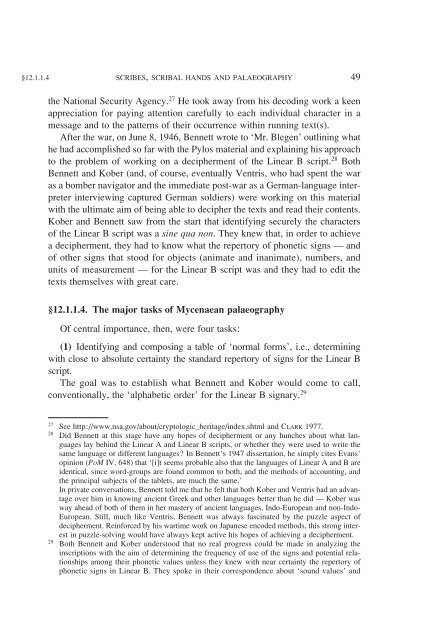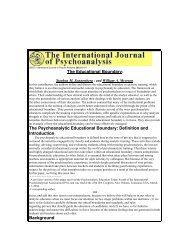A Companion to Linear B - The University of Texas at Austin
A Companion to Linear B - The University of Texas at Austin
A Companion to Linear B - The University of Texas at Austin
Create successful ePaper yourself
Turn your PDF publications into a flip-book with our unique Google optimized e-Paper software.
§12.1.1.4 SCRIBES, SCRIBAL HANDS AND PALAEOGRAPHY 49<br />
the N<strong>at</strong>ional Security Agency. 27 He <strong>to</strong>ok away from his decoding work a keen<br />
appreci<strong>at</strong>ion for paying <strong>at</strong>tention carefully <strong>to</strong> each individual character in a<br />
message and <strong>to</strong> the p<strong>at</strong>terns <strong>of</strong> their occurrence within running text(s).<br />
After the war, on June 8, 1946, Bennett wrote <strong>to</strong> ‘Mr. Blegen’ outlining wh<strong>at</strong><br />
he had accomplished so far with the Pylos m<strong>at</strong>erial and explaining his approach<br />
<strong>to</strong> the problem <strong>of</strong> working on a decipherment <strong>of</strong> the <strong>Linear</strong> B script. 28 Both<br />
Bennett and Kober (and, <strong>of</strong> course, eventually Ventris, who had spent the war<br />
as a bomber naviga<strong>to</strong>r and the immedi<strong>at</strong>e post-war as a German-language interpreter<br />
interviewing captured German soldiers) were working on this m<strong>at</strong>erial<br />
with the ultim<strong>at</strong>e aim <strong>of</strong> being able <strong>to</strong> decipher the texts and read their contents.<br />
Kober and Bennett saw from the start th<strong>at</strong> identifying securely the characters<br />
<strong>of</strong> the <strong>Linear</strong> B script was a sine qua non. <strong>The</strong>y knew th<strong>at</strong>, in order <strong>to</strong> achieve<br />
a decipherment, they had <strong>to</strong> know wh<strong>at</strong> the reper<strong>to</strong>ry <strong>of</strong> phonetic signs — and<br />
<strong>of</strong> other signs th<strong>at</strong> s<strong>to</strong>od for objects (anim<strong>at</strong>e and inanim<strong>at</strong>e), numbers, and<br />
units <strong>of</strong> measurement — for the <strong>Linear</strong> B script was and they had <strong>to</strong> edit the<br />
texts themselves with gre<strong>at</strong> care.<br />
§12.1.1.4. <strong>The</strong> major tasks <strong>of</strong> Mycenaean palaeography<br />
Of central importance, then, were four tasks:<br />
(1) Identifying and composing a table <strong>of</strong> ‘normal forms’, i.e., determining<br />
with close <strong>to</strong> absolute certainty the standard reper<strong>to</strong>ry <strong>of</strong> signs for the <strong>Linear</strong> B<br />
script.<br />
<strong>The</strong> goal was <strong>to</strong> establish wh<strong>at</strong> Bennett and Kober would come <strong>to</strong> call,<br />
conventionally, the ‘alphabetic order’ for the <strong>Linear</strong> B signary. 29<br />
27 See http://www.nsa.gov/about/cryp<strong>to</strong>logic_heritage/index.shtml and CLARK 1977.<br />
28 Did Bennett <strong>at</strong> this stage have any hopes <strong>of</strong> decipherment or any hunches about wh<strong>at</strong> languages<br />
lay behind the <strong>Linear</strong> A and <strong>Linear</strong> B scripts, or whether they were used <strong>to</strong> write the<br />
same language or different languages? In Bennett’s 1947 dissert<strong>at</strong>ion, he simply cites Evans’<br />
opinion (PoM IV, 648) th<strong>at</strong> ‘[i]t seems probable also th<strong>at</strong> the languages <strong>of</strong> <strong>Linear</strong> A and B are<br />
identical, since word-groups are found common <strong>to</strong> both, and the methods <strong>of</strong> accounting, and<br />
the principal subjects <strong>of</strong> the tablets, are much the same.’<br />
In priv<strong>at</strong>e convers<strong>at</strong>ions, Bennett <strong>to</strong>ld me th<strong>at</strong> he felt th<strong>at</strong> both Kober and Ventris had an advantage<br />
over him in knowing ancient Greek and other languages better than he did — Kober was<br />
way ahead <strong>of</strong> both <strong>of</strong> them in her mastery <strong>of</strong> ancient languages, Indo-European and non-Indo-<br />
European. Still, much like Ventris, Bennett was always fascin<strong>at</strong>ed by the puzzle aspect <strong>of</strong><br />
decipherment. Reinforced by his wartime work on Japanese encoded methods, this strong interest<br />
in puzzle-solving would have always kept active his hopes <strong>of</strong> achieving a decipherment.<br />
29 Both Bennett and Kober unders<strong>to</strong>od th<strong>at</strong> no real progress could be made in analyzing the<br />
inscriptions with the aim <strong>of</strong> determining the frequency <strong>of</strong> use <strong>of</strong> the signs and potential rel<strong>at</strong>ionships<br />
among their phonetic values unless they knew with near certainty the reper<strong>to</strong>ry <strong>of</strong><br />
phonetic signs in <strong>Linear</strong> B. <strong>The</strong>y spoke in their correspondence about ‘sound values’ and

















